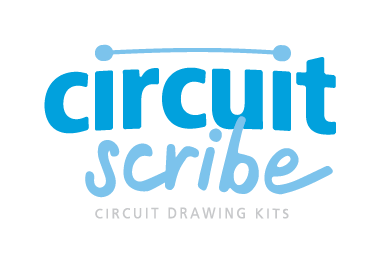Module Tech Specs
The 9V battery component provides power to your circuit. It contains an on/off switch, so power to your circuit can be controlled at the source. Turning off the battery module when you are not using it also helps you conserve the battery’s power. A blue LED indicates when the power is on, while a red LED indicates when the battery is shorted, at 250mA of current. In the event of a short circuit, it has protective circuitry including diodes, fuses, resistors and capacitors so that it does not blow. The battery is attached via the adapter on the module. Match the smaller terminal on the battery with the larger on the adapter and the larger terminal on the battery to the smaller on the adapter and press to snap battery into place.
The USB module supplies 5 volts to a circuit when plugged into a USB port. It has a blue LED to indicate that power is being supplied to the module and a red LED to indicate that the module has been shorted at 250mA. In the event of a short circuit, it has protective circuitry including diodes, fuses, resistors and capacitors so that it does not blow.
The 6-terminal DPDT (double-pole double-throw) module has two switches operated by one lever. Both 3-terminal switches (each with one pole and two throws) toggle between two connections, allowing you to control two circuits at one time.
The SPST (single-pole, single-throw) Switch has a single input and a single output. The input and output are either connected or not connected. Flipping the switch causes it to change between the two states, allowing you to control the input or output to a specific part of your circuit. Though our version of this switch acts like an SPST, it is actually a DPDT wired to do so. The DPDT is wired to switch between two states: connecting the two feet (on state) and connecting one foot to itself (off state).
The Photo Sensor module contains a phototransistor that acts much like a normal transistor. Light hitting the phototransistor creates a current flowing into base, turning the transistor on and allowing current to flow from the collector to the emitter. If there is no load connected at the output and the transistor is on, the resistance at the output will be infinite and current will flow through the 10k resistor after the output. If there is a load connected at the output, some of the current will flow through the load at the output, while some will flow through the resistor after the output. The more light shined on the phototransistor, the better it works as an amplifier, and the larger the outputted signal at the emitter.
The Potentiometer divides resistance by splitting a single resistor into two parts. When the dial is turned, it is moving a wiper along the resistor. The wiper is splits the resistor at that point, changing the resistance between each terminal and the output at the wiper. The resistance between node 1 and node 2 always remain the same, and is equal to the sum of the resistance between node 1 and the wiper and node 2 and the wiper. Having the ability to divide the resistance also allows you to divide voltage and current, giving you control over the power supplied to parts of your circuit.
The 2- pin component is used to incorporate through hole components into circuits. The module has two pairs of vias on top, allowing two components to be put in parallel. Components should be inserted across the resistor symbol in the middle of the module. If you flip it over, you will see a 2x4 header. The four sockets on the left are all connected (node 1) and so are the four sockets on the right (node 2). Each node is connected to the foot closest to it. If two or more components are inserted with one pin in each node, the components share 2 nodes, and therefore are in parallel.
The buzzer module uses a 4kHz fixed frequency, piezoelectric DC buzzer which operates in one direction. An internal oscillator produces the 4kHz alternating current, creating the pitch. The alternating voltage from the oscillator causes the piezoelectric material to change shape, creating the sound. An increased voltage will increase the deformation of the piezoelectric material, increasing the amplitude of the sound wave being produced and making a louder sound.
The connector has our magnetic foot on one end and a lead wire on the other. This allows you to connect a drawn trace to a socket on devices such as a breadboard, Arduino port, or Makey-Makey.
The DIY Board allows you to connect a more complicated chips to your traces. The chips can have up to 8 pins and can be soldered to the pads or inserted into the through holes. However, through hole components can be harder to use do to varying wire thicknesses. The numbers next to the feet indicate the pin number that it attaches to at each component insertion spot. Breaking apart the different sections breaks the connection between the feet and their corresponding pins in other sections and allows you to customize your board. Apart from the four spots for components with up to 8 pins, there is a spot for a 2-pin component between feet 9 and 10.
The NPN Transistor module contains an NPN Transistor and a resistor in the wire leading up to the base to protect it. There are also to diodes to protect the transistor by ensuring that current does not flow into the transistor the wrong way. When there is even a small amount of current at the base foot, there is a current large enough to turn on the transistor, allowing a large current to flow through from the collector to the emitter. This allows you to show a small change at the base to be shown as a large one through the emitter and collector.
The Bi-LED module contains a red-blue Bi-LED. Each LED only allows current to flow through it in one direction. The LEDs are connected in opposite directions, allowing the module to operate in both directions. When current flows through the LED, it lights up. Thus, the red LED lights up when current flows in one direction and the blue lights up when current flows in the opposite direction. It takes 1.8V to power red LED and 2.5V to power the blue LED. There are resistors before each LED on the module to protect them.
The buzzer module uses a 4kHz fixed frequency, piezoelectric DC buzzer which operates in one direction. An internal oscillator produces the 4kHz alternating current, creating the pitch. The alternating voltage from the oscillator causes the piezoelectric material to change shape, creating the sound. An increased voltage will increase the deformation of the piezoelectric material, increasing the amplitude of the sound wave being produced and making a louder sound.
The Motor module contains a small electric motor that operates between 8V and 12V. It will operate in both directions. The direction of the motor depends on the direction of the current. Adjusting the power to the motor will adjust the speed at which it spins. However, there is not much room for down adjustment in most cases since the motor requires nearly all of the power our 9V power source can produce.
The RGB LED is a module containing Red, Green, and Blue LEDs within a single component. There is a foot to control each color and a common ground foot. Each LED has its own resistor to protect it, as well as to maintain a consistent brightness between the 3 LEDs. Since they are LEDs, they only operate with current flow in one direction. The power at the foot for the given color must be higher than that at the ground foot to turn on the LED. There are 7 unique color combinations that can be obtained with this module through turning on and off the 3 LEDs.

